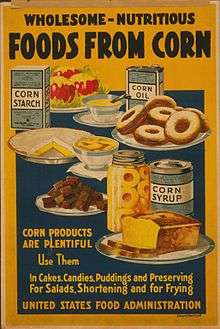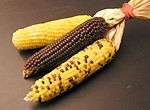Corn starch
Corn starch, maize starch, or corn flour (British English) is the starch derived from corn (maize) grain.[1] The starch is obtained from the endosperm of the kernel. Corn starch is a common food ingredient, often used to thicken sauces or soups, and to make corn syrup and other sugars.[2] Cornstarch is versatile, easily modified, and finds many uses in industry such as adhesives, in paper products, as an anti-sticking agent, and textile manufacturing.[3] It has medical uses as well, such as to supply glucose for people with glycogen storage disease.[4]
| 381 kcal (1595 kJ) | |||||||
| |||||||
Like many products in dust form, it can be hazardous in large quantities due to its flammability. When mixed with a fluid, cornstarch can rearrange itself into a non-Newtonian fluid. For example, adding water transforms cornstarch into a material commonly known as oobleck while adding oil transforms cornstarch into an electrorheological (ER) fluid. The concept can be explained through the mixture termed "cornflour slime".[5]
History
Until 1851, corn starch was used primarily for starching laundry and for other industrial uses.
Uses
Although mostly used for cooking and as a household item, cornstarch is used for many purposes in several industries, ranging from its use as a chemical additive for certain products, to medical therapy for certain illnesses.
Culinary
Cornstarch is used as a thickening agent in liquid-based foods (e.g., soup, sauces, gravies, custard), usually by mixing it with a lower-temperature liquid to form a paste or slurry. It is sometimes preferred over flour alone because it forms a translucent, rather than opaque mixture. As the starch is heated, the molecular chains unravel, allowing them to collide with other starch chains to form a mesh, thickening the liquid (Starch gelatinization).
It is usually included as an anticaking agent in powdered sugar (icing or confectioner's sugar).
A common substitute is arrowroot starch, which replaces the same amount of cornstarch.[6]
Food producers reduce production costs by adding varying amounts of cornstarch to foods, for example to cheese and yogurt.[7]
Chicken nuggets with a thin outer layer of cornstarch allows increased oil absorption and crispness after the latter stages of frying.[8]
Non-culinary
Baby powder may include cornstarch among its ingredients.[9] Cornstarch can be used to manufacture bioplastics and may be used in the manufacture of airbags.
Adhesive can be made from corn starch, traditionally one of the adhesives that may be used to make paste papers. It dries with a slight sheen compared to wheat starch. It may also be used as an adhesive in book and paper conservation.
Medical
Cornstarch is the preferred anti-stick agent on medical products made from natural latex, including condoms, diaphragms, and medical gloves.[10][11]
Cornstarch has properties enabling supply of glucose to maintain blood sugar levels for people with glycogen storage disease.[12] Cornstarch can be used starting at age 6–12 months allowing glucose fluctuations to be deterred.[13]
Manufacture

The corn is steeped for 30 to 48 hours, which ferments it slightly. The germ is separated from the endosperm and those two components are ground separately (still soaked). Next the starch is removed from each by washing. The starch is separated from the corn steep liquor, the cereal germ, the fibers and the corn gluten mostly in hydrocyclones and centrifuges, and then dried. (The residue from every stage is used in animal feed and to make corn oil or other applications.) This process is called wet milling. Finally, the starch may be modified for specific purposes.[14]
Risks
Like many other powders, cornstarch is susceptible to dust explosions. It is believed that overheating of a cornstarch-based powder on 27 June 2015, initiated the Formosa Fun Coast explosion in Taiwan, despite warnings on the packaging indicating that the material is flammable.[15]
Names and varieties
- Called corn starch in the United States and Canada. The term corn flour refers to cornmeal that is very finely milled.
- It is called cornflour in the United Kingdom,[16] Ireland, Israel and some Commonwealth countries. Distinct in these countries from cornmeal.
See also
- Amylomaize, high amylose starch
- Bird's Custard, the English custard based on cornflour, invented in 1837
- Waxy corn, waxy maize starch
- Corn sauce
- Corn syrup
- Corn ethanol
- Modified starch
- Potato starch
- Tapioca starch
References
- "Cornstarch | Definition of Cornstarch by Merriam-Webster". Merriam-webster.com. Archived from the original on 2016-03-04. Retrieved 2016-05-14.
- "Uses of Corn". www2.education.uiowa.edu. Retrieved 2018-01-11.
- Starch : chemistry and technology. Whistler, Roy Lester., BeMiller, James N., Paschall, Eugene F. (2nd ed.). Orlando: Academic Press. 1984. Chap. 6, p. 121. ISBN 978-0-12-746270-7. OCLC 9155004.CS1 maint: others (link)
- Gremse, D.A.; Bucuvalas, J. C.; Balistreri, W. F. (October 1990). "Efficacy of cornstarch therapy in type III glycogen-storage disease". The American Journal of Clinical Nutrition. 52 (4): 671–674. doi:10.1093/ajcn/52.4.671. ISSN 0002-9165. PMID 2403059.
- "How to: make a liquid that's also a solid". bbc.co.uk. 2013-08-05. Archived from the original on 2016-12-12. Retrieved 2016-12-03.
- "Ingredient Substitution". JoyofBaking.com. 2007-09-11. Archived from the original on 2011-05-10. Retrieved 2011-06-12.
- "High-Tech Shortcut To Greek Yogurt Leaves Purists Fuming". NPR.org. Retrieved 2018-01-11.
- Bilge Altunaker; Sepil Sahin; Gulum Sumnu (March 2004). "Functionality of batters containing different starch types for deep-fat frying of chicken nuggets". European Food Research and Technology. 218 (4): 318–322. doi:10.1007/s00217-003-0854-5.
- Manley, Duncan (1998). Biscuit, cookie and cracker manufacturing manuals – Manual 1 – Ingredients. Cambridge, England: Woodhead Publishing Limited. p. 34. ISBN 1-85573-292-0.
- "Women's health concerns prompt condom makers to stop using talc". The Free Lance-Star. January 11, 1996. p. D3. Retrieved 14 May 2016 – via Google News Archive Search.
- "Medical Glove Powder Report". Fda.gov. Archived from the original on 2016-05-12. Retrieved 2016-05-14.
- "A Sweet Discovery". University of Florida Health. Archived from the original on 5 March 2017. Retrieved 23 March 2017.
- "GSD Type 1". GSD Life. Archived from the original on 2013-11-02. Retrieved 2013-10-31.
- "International Starch: Production of corn starch". Starch.dk. Archived from the original on 2011-05-15. Retrieved 2011-06-12.
- Mullen, Jethro; Novak, Kathy; Kwon, K.J. "'All her skin was gone': Horrific aftermath of fireball at Taiwan water park". CNN. Archived from the original on 18 January 2017. Retrieved 23 March 2017.
- "BBC – Food – Cornflour recipes". BBC. Archived from the original on 12 May 2017. Retrieved 13 August 2017.
External links
| Wikibooks has a book on the topic of: Cookbook:Cornstarch |
